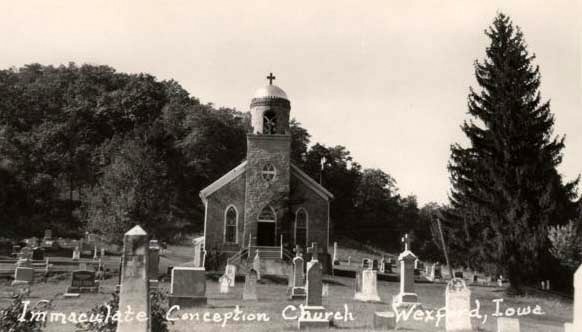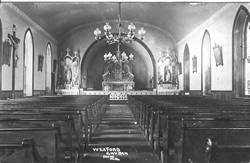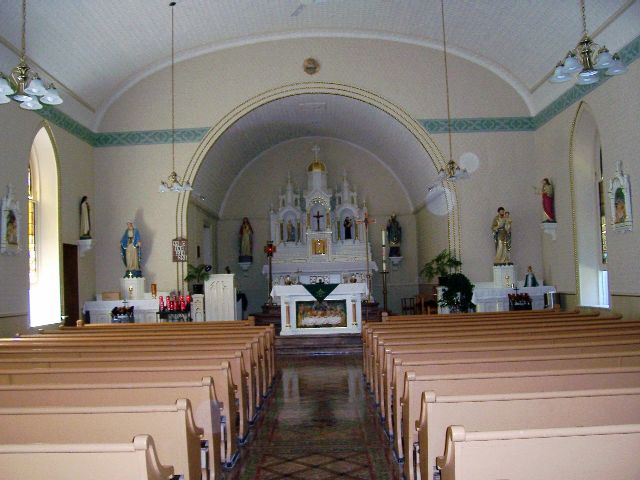THE WEXFORD CHURCH
By Bud Stickler
The unusual and picturesquely-located church at
Wexford marks the arrival in Iowa of its first large
group of Irish immigrants in 1851 when the weary
remnants of a band from Ireland’s County Wexford
set tled in Allamakee County. Their road had been a
long and tragic one marked by an arduous voyage,
deception by promoters, pestilence, uncertainty, and
the graves of their loved ones.
The decision to leave their homeland was not lightly
made. But the potato famines that began in 1848 were
the final blow to these people. They had already
suffered under a tenancy system that had reduced
farming to a kind of weary serfdom through its
"rack rents.”
Most of the farmers and villagers who made up the
emigrants were from Parish Annacura and Kilaveny in
County Wexford—there were originally
twelve-hundred in the group. Their leader and pastor,
Father Thomas Hore, had lived for a while in America.
He had finished his studies for the priesthood in
Virginia and had been ordained there.
In 1850 they sailed from Liverpool, England, in
"coffin ships" bound for New Orleans. The
emigrants had split into groups of families, and
Father Hore had seventy-five families under his
immediate care. Land promoters had assured them that
Arkansas would be their new haven. In fact, there
were supposed to be other Irish immigrants in that
vicinity who would be their neighbors.
As soon as they landed, however, about a third of the
party split from the others and hastened to Refugio,
Texas—probably induced by speculators and
sharpers with talk of cheap land and easy fortunes
waiting for them. But the majority headed
determinedly for their original goal—a
settlement near Little Rock, Arkansas.
During their first few months death was a constant
companion. A cholera-like epidemic struck the
settlers and many perished. Discouraged, the little
band fled the scene of its sorrow and scattered. Some
moved to Little Rock and Fort Smith, while others
journeyed to St. Louis. None of the families remained
in their original home. They were no longer a tight
little band, but only immigrants scattered across an
unknown land.
In the meantime, Father Hore was trying to regroup
his people and find them a new home. With only faith
and determination to guide him, he sailed up the
Mississippi River to Dubuque, where he conferred with
Bishop Mathias Loras and with the Trappist monks of
nearby New Melleray about the need of a suitable
location for his families. After learning all he
could from his sympathetic friends, Father Hore set
out with a surveyor to comb the area north of
Dubuque. He selected a site in Allamakee County with
plenty of springs and timber.
Returning to Dubuque, Father Hore obtained title to
twelve hundred acres of government land from the land
office. He then hurried to St. Louis with the news.
Eighteen of the original families from County Wexford
decided once again to cast their lot with their
priest and trekked up the Mississippi to begin a new
Wexford.
While the settlers were buckling down to the hard
work of wresting farms from the forest, Father Hore
began building a log church for his people. When it
was finished, the rustic structure was dedicated in
honor of St. George, the warrior saint. In 1856 a
larger frame church was erected, and in 1868 the
present church was built of Niagara limestone with
the parishioners donating their labor. The stone was
quarried from nearby hillsides and hauled to the site
by teams of oxen.
Father Hore remained to see his community off to a
steady start—by 1868 there were one hundred
families in the parish—and returned to his home
in Ireland. A Father Walsh then assumed the
pastor’s duties. At the present time, Father
A.P. White is the country church’s pastor, and
the church is now named Immaculate Conception.
Although the Wexford countryside is ruggedly
beautiful, the sudden hills, dense hardwood forests,
and flowing creeks make farming difficult. Some say
the Irish must have stayed because of plain
cussedness. But stay they did. These stubborn
Irishmen had traveled far enough. So they cleared the
woods where they could, and Wexford’s
agriculture began.
In some ways the Wexford community of today is much
the same as it was one hundred years ago. For it
never did become a town. It consists of individual
farms scattered in the hills and hollows around the
church. And, although there are now a few farmers of
German descent in the area, most of the names on the
mail boxes are pure Gaelic. The brogues may be gone,
but you can still hear the Irish in the voices of
these folk.
~The Iowan June-July 1957
~contributed by Errin Wilker
![]()


